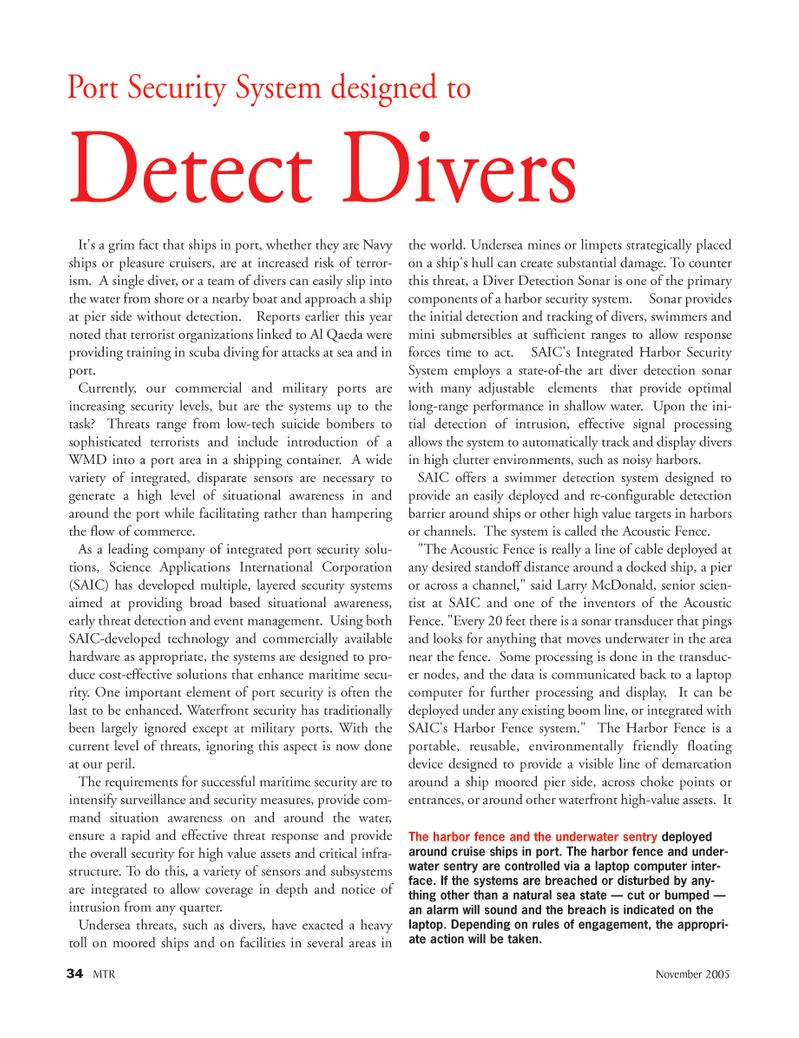
Page 34: of Marine Technology Magazine (November 2005)
Seafloor Engineering
Read this page in Pdf, Flash or Html5 edition of November 2005 Marine Technology Magazine
It's a grim fact that ships in port, whether they are Navy ships or pleasure cruisers, are at increased risk of terror- ism. A single diver, or a team of divers can easily slip into the water from shore or a nearby boat and approach a ship at pier side without detection. Reports earlier this year noted that terrorist organizations linked to Al Qaeda were providing training in scuba diving for attacks at sea and in port.
Currently, our commercial and military ports are increasing security levels, but are the systems up to the task? Threats range from low-tech suicide bombers to sophisticated terrorists and include introduction of a
WMD into a port area in a shipping container. A wide variety of integrated, disparate sensors are necessary to generate a high level of situational awareness in and around the port while facilitating rather than hampering the flow of commerce.
As a leading company of integrated port security solu- tions, Science Applications International Corporation (SAIC) has developed multiple, layered security systems aimed at providing broad based situational awareness, early threat detection and event management. Using both
SAIC-developed technology and commercially available hardware as appropriate, the systems are designed to pro- duce cost-effective solutions that enhance maritime secu- rity. One important element of port security is often the last to be enhanced. Waterfront security has traditionally been largely ignored except at military ports. With the current level of threats, ignoring this aspect is now done at our peril.
The requirements for successful maritime security are to intensify surveillance and security measures, provide com- mand situation awareness on and around the water, ensure a rapid and effective threat response and provide the overall security for high value assets and critical infra- structure. To do this, a variety of sensors and subsystems are integrated to allow coverage in depth and notice of intrusion from any quarter.
Undersea threats, such as divers, have exacted a heavy toll on moored ships and on facilities in several areas in the world. Undersea mines or limpets strategically placed on a ship's hull can create substantial damage. To counter this threat, a Diver Detection Sonar is one of the primary components of a harbor security system. Sonar provides the initial detection and tracking of divers, swimmers and mini submersibles at sufficient ranges to allow response forces time to act. SAIC's Integrated Harbor Security
System employs a state-of-the art diver detection sonar with many adjustable elements that provide optimal long-range performance in shallow water. Upon the ini- tial detection of intrusion, effective signal processing allows the system to automatically track and display divers in high clutter environments, such as noisy harbors.
SAIC offers a swimmer detection system designed to provide an easily deployed and re-configurable detection barrier around ships or other high value targets in harbors or channels. The system is called the Acoustic Fence. "The Acoustic Fence is really a line of cable deployed at any desired standoff distance around a docked ship, a pier or across a channel," said Larry McDonald, senior scien- tist at SAIC and one of the inventors of the Acoustic
Fence. "Every 20 feet there is a sonar transducer that pings and looks for anything that moves underwater in the area near the fence. Some processing is done in the transduc- er nodes, and the data is communicated back to a laptop computer for further processing and display. It can be deployed under any existing boom line, or integrated with
SAIC's Harbor Fence system." The Harbor Fence is a portable, reusable, environmentally friendly floating device designed to provide a visible line of demarcation around a ship moored pier side, across choke points or entrances, or around other waterfront high-value assets. It 34 MTR November 2005
Port Security System designed to
Detect Divers
The harbor fence and the underwater sentry deployed around cruise ships in port. The harbor fence and under- water sentry are controlled via a laptop computer inter- face. If the systems are breached or disturbed by any- thing other than a natural sea state — cut or bumped — an alarm will sound and the breach is indicated on the laptop. Depending on rules of engagement, the appropri- ate action will be taken.
MTR#3 (33-48).qxd 11/14/2005 1:21 PM Page 34

 33
33

 35
35
